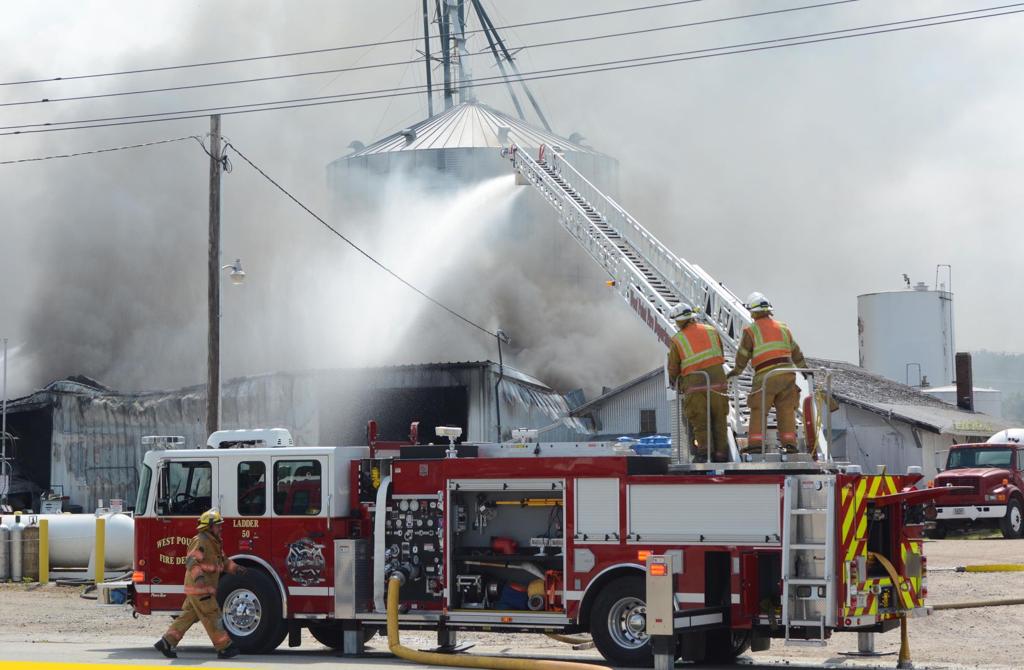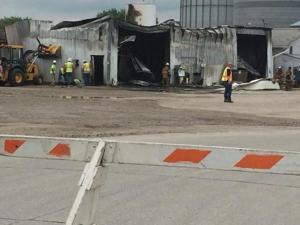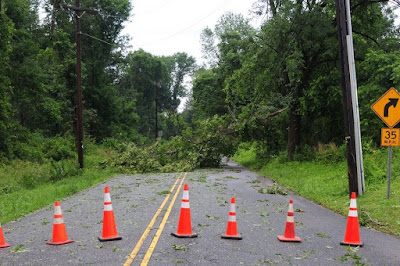JULY 2, 2015 @ 0250. CSX train derailment at Mt. Tabor at Old Mt. Tabor. At least one car containing a highly flammable and toxic gas detailed and is on fire. Evacuation area includes a one mile radius from the derailment. Red Cross shelter at Heritage High School. Evacuation could last from 24 to 48 hours. Will update asap.
Seven sheriff's officers were taken to hospital after breathing in fumes from the blaze, Blount County Sheriff's Department spokeswoman Marian O'Briant told NBC News.
An evacuation zone is in place over a two-mile radius from the derailment, near Maryville, and could be in place for up to 48 hours, the fire department said.
Two shelters are being opened for residents including one at a local high school, according to David Kitchen, senior disaster program Manager for the Tennessee Volunteer Region of the Red Cross.
The train was carrying Acrylonitrile — which authorities described as a "highly flammable and toxic gas."
Up to three cars were ablaze, O'Briant said, but it was no immediately clear if the fire was under control.
The CSX train was traveling from Cincinnati, Ohio to Waycross, Georgia and consisted of two locomotives, 45 loaded rail cars carrying mixed freight and 12 empty rail cars, company spokeswoman Kristin Seay told NBC News. One car derailed, she said.
///------------------///
UPDATE 4:58 AM Red Cross shelter at Heritage High now open and accepting evacuees from the Maryville train detailment. Authorities estimate 5000 people evacuated from 2 mile radius of CSX train derailment that sparked a fire of toxic chemical in Maryville just after midnight.
UPDATE 4:54 A.M. At this point more evacuees have come to Heritage High and left than are still waiting for Red Cross center to come on line. Much of what BC Red Cross needs is actually inside the evacuation zone which is complicating the shelter opening.
UPDATE 4:41 AM Red Cross close to
letting evacuees inside at Heritage High. Evacuees experiencing medical
problems or who left homes without neccesary medication such as
diabetes or other timely meds should report that to Red Cross volunteers
set up in front of schools office.
Again Heritage will not be set up for pets to go inside the school.
UPDATE 427 A.M. Blount County
Sheriffs Office confirms that evacuation zone has been expanded to 2
mile radius from site of train derailment with toxix chemical fire.
Estimate 5,000 people now evacuated or in process of being evacuated for
a 24 to 48 hour period. Heritage High is being set up as Red Cross
shelter with Heritage Middle as overflow facility. Area includes
industrial park and Alcoa Walmart. Includes DENSO.
UPDATE 4:20 AM. Heritage High shelter will not be able to accomodate pets inside when it opens.
UPDATE 4:11 Evacuation area is
being expanded to a wider area. Estimates from BCSO now say as many
5,000 people may be evacuated for 24 to 48 hours.
UPDATE (4 A.M.) At Heritage High -
Blount County Red Cross is awaiting supplies from Knox County. The BCs
office is within evacuation zone and volunteers could not get to much of
the local resources.
Volunteers at Heritage High are
going to begin moving evacues from outside and school parking lot and
into the gym shortly to begin registering and checking them in to
shelter.
Much of what they need to set up basics expected to arrive shortly.
UPDATE (3:50 A.M.) BC Sheriffs
office corfirms some other areas near derailment are closing or
evacuating, that includes Alcoa Walmart.
UPDATE: Maryville Police now clearing mall lot and directing evacuees to Heritage High saying "perimeter is being expanded."
UPDATE (3:26 A.M.) DENSO is now evacuating its facility as well.
The CSX tanker car carrying
Acrylonitrile derailed just after midnight Thursday morning forcing the
evacuation of more than 1,200 people.
According to Blount County
Sheriff’s Office spokeswoman Marian O’Briant, one car was confirmed to
have derailed at Old Mt. Tabor Road in Maryville. The car is on fire and
the CSX train, containing nine total cars carrying the
highly flammable and toxic colorless liquid, was being checked for any
further derailments.
"So far they've evacuated about
100 people but they are getting ready to begin evacuations of camellia
Trace Apartments, which has about 1,000 people," O'Briant said just
after 2 a.m. from the evacuation site at Foothills Mall.
Evacuees are initially being sent
to Foothills Mall. The facility is being opened to provide basic
initial services. A Red Cross shelter is being set up at Heritage High
School to handle an estimated 1,200 evacuees, who fall within the 1-mile
safety radius of the derailment.
Members of Maryville Police,
Maryville Fire, Blount County Sheriff's office, Blount County Fire, TEMA
are responding to the scene. Responders near the scene are using hazmat
gear and going door-to-door evacuating residences and businesses.
"They knocked on my door at 2:30 and woke me up," Rodney Duncan told The Daily Times.
Duncan, who owns a tiling business put on work clothes, packed up his dogs Maycee and Leo, and joined the evacuees at the mall.
"I guess I'll have to take them to work with me today."
According to O'Briant the evacuation may last 24 to 48 hours.
The cause of the derailment is
not yet known. Officials have blocked several roads leading to the area
as the evacuation proceeds, but a full list is not yet available.
Acrylonitrile is highly flammable
and toxic. It undergoes explosive polymerization. The burning material
releases fumes of hydrogen cyanide and oxides of nitrogen. It is
classified as a Class 2B carcinogen (possibly carcinogenic) by the
International Agency for Research on Cancer and is listed on the
Environmental Protection Agency's website for Air Toxics.
O'Briant also reported that
HEPACO, a company that specializes in train derailments was also on the
scene. According to the company's website it is "one of the top
environmental and emergency response companies in America."
The last derailment in the area
was classified as "minor" in February of 2006 when a Norfolk Southern
train derailed in Alcoa and blocked Lincoln Road. In 2005, The Daily
Times reported a 95-car CSX train on Aug. 15, 2005, at West Hunt Road
and Armona Road. The cause for that incident was later blamed on a
buckled track caused by intense heat.
















